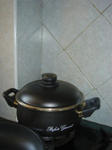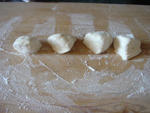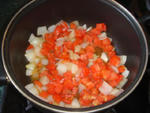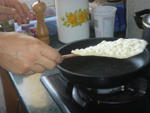Trying to revive this habit, i am posting today about making a challah. It actually works out well for many friends asked me to share a recipe for some Jewish food and this one is probably among the few that are traditionally Jewish.
Before i start, i have to confess that while making the challah i cheat. I am using a breadmaker to make the dough. I believe you can do it without using technology, but i confess it makes the life much easier. In fact, breadmaker was probably one of the best pieces of kitchenware i've ever got. Hopefully i will share some interesting bread recipes in the future.
The recipe i used for challah offers two versions of quantities - for a regular challah and for a large one. Yesterday i made a large one (on the first picture), but today i divided the dough in two parts and am trying to make two smaller challahs instead of a large one. So, for the breadmaker version of the dough for a large challah you need:
- 2 eggs (room temperature) + water to equal the whole thing 1.5 cups of liquids
- 1/4 cup of oil ( i am using olive)
- 4.5 cups of bread flour (in case you've never baked bread, it is different from an all pupose flour and it is apparently important)
- 2 TBL of sugar
- 2 tsp of salt (i am using sea salt which is larger than the regular table salt)
- 1.25 tsp of bread machine yeast or 2 tsp of active dry yeast
Now, a couple of things i learned working with the breadmaker (skip it if you have the experience). First, it is a good practice to add a little bit less flour than the recipe suggests. Theoretically you can add more in the process (providing you are monitoring the process), but i never had to do it yet. At the same time i saw results of adding too much flour and trust me, it wasn't good. Another thing is about order of putting the things together into the machine - first you put in liquids, then everything else with the yeast very last. Basically, the order i put things in is the order i listed them. And finally, a method of adding yeast that i learned from a RU booklet on breadmaking i got from my sister. You simply make small halls in the flour and other dry ingredients, and then pour the yeast there. It works.
In the breadmaker i have it takes about and hour and 20 minutes for the dough to be ready. From my end it takes 5 minutes to put all the ingredients together and the come back after 1 hour and 20 minutes and have a ready dough.
In the breadmaker i have it takes about and hour and 20 minutes for the dough to be ready. From my end it takes 5 minutes to put all the ingredients together and the come back after 1 hour and 20 minutes and have a ready dough.
The machine knits it, lets it rest, knits it again, etc. I believe the hand process is a bit different, but i guess it is close enough.
After the dough was ready i divided it in two halves (one for each challah) and then each one was divided in three (the original recipe suggest dividing the whole amount in three and then making one huge challah).
After the dough was ready i divided it in two halves (one for each challah) and then each one was divided in three (the original recipe suggest dividing the whole amount in three and then making one huge challah).
Then i each one of the small balls was made into a rope, 2-3 cm in diameter (about 4 cm for the large challah) and 20 cm long (a bit longer for the huge one).
The next step is braiding the three ropes together. For that purpose you have to pinch them on the one side, braid, and then pinch on the other.
The final result should be something like this.
Next you place the challah/s on greased baking sheet, cover it with a towel and let it rest in a warm place for about an hour.
During this time the challahs are supposed to rise and practically double themselves in size. This what my challahs looked after almost an hour.
At the next stage you heat the stove to 350F/177C. While it is heating you are taking on egg yolk (the original recipe says 2, but i think 1 is enough) and beat it with 1 TBL of water. Then you brush it onto the challahs and as a final touch sprinkle some sesame or poppy seeds on the top of it.
When everything is ready, you send the challahs into the stove for about 20 minutes (25 minutes for the huge challah). I test if its done by sticking a toothpick and seeing if it comes out dry.
That's basically it... Enjoy the challah, from my experience it turns out really great. Try it with Nutella or other chocolate... it is good!






